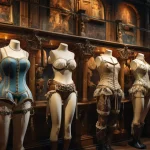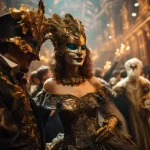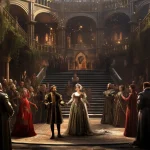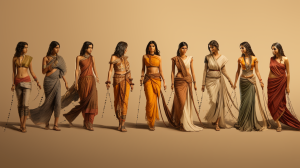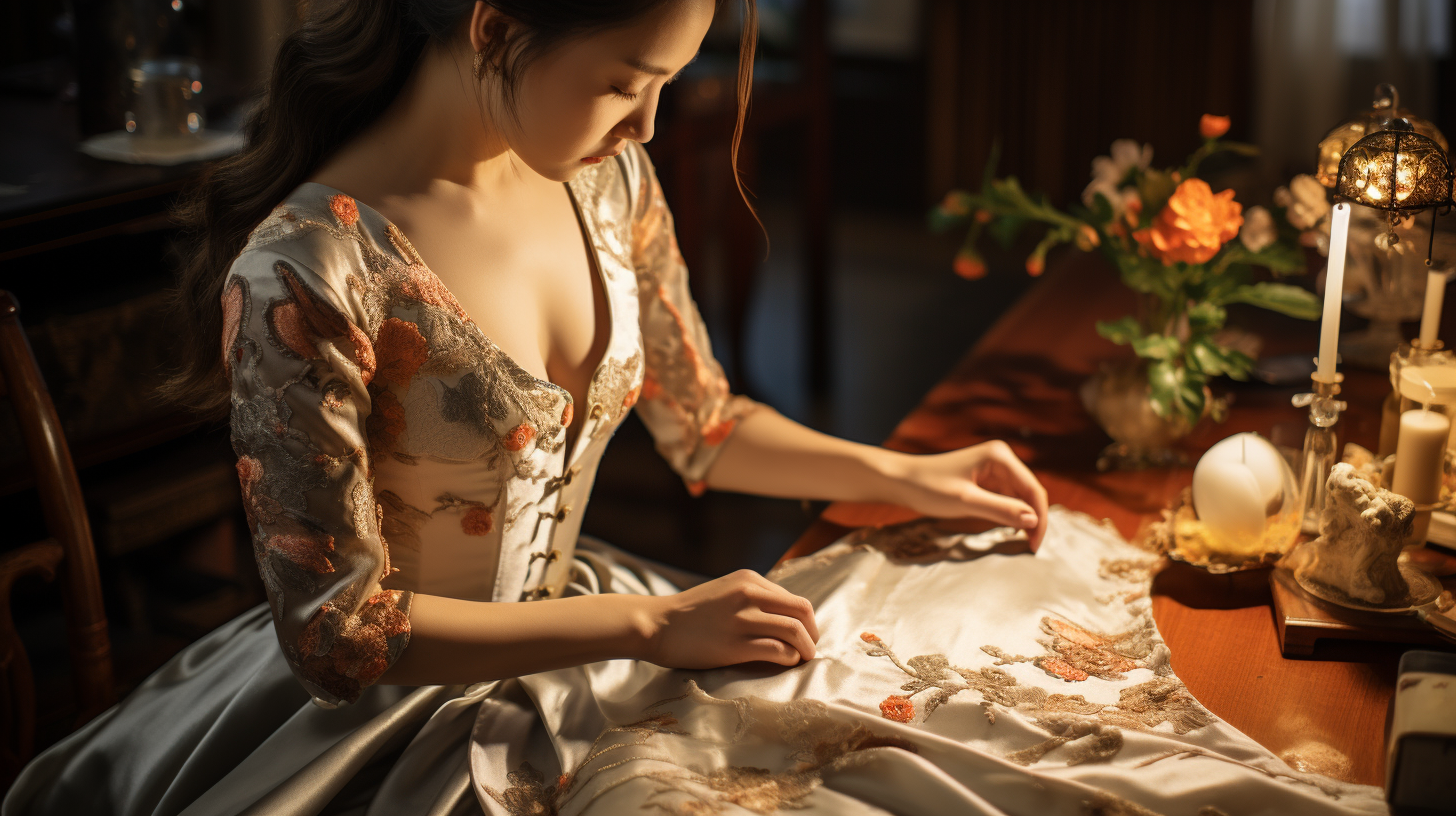
A Tapestry Unfurling: The Fabric of Ancient China’s Soul
Hello, dear readers, and welcome to an exquisite exploration that takes us deep into the heart of the Middle Kingdom. Imagine walking through a living museum where each piece of fabric, each strand of silk, tells a tale. Oh yes, if walls could talk, they’d be utterly upstaged by robes, gowns, and brocades that have more stories to tell than an old sailor in a dimly-lit bar.
Let’s take this journey seriously; after all, it’s not just about “looking good” or “fashion” as you might casually toss around these words today. What we’re about to dive into is the epitome of class, culture, and deep-rooted tradition. It’s the narrative of Chinese dynasties fashion, a subject that has fascinated minds as much as it has adorned bodies, all while intricately intertwining itself with the very essence of Chinese society. 🌸
I’m not talking about a simple warp and weft of threads; oh no. This is about how each fabric, each style, and indeed, each stitch played a role in the grander scheme of societal structures, historical shifts, and cultural values. The fabric here doesn’t just clothe; it speaks, it represents, it commands respect. The clothes in these dynasties were like silent emperors, each telling us who’s in power, who’s fallen out of grace, and most importantly, who you are in the grand tapestry of life.
Imagine a world where your hairstyle could speak volumes about your social standing, where the intricate designs on your robe could tell a story far more intricate than any book, and where the colors you adorn are not just a fashion statement but a declaration of your innermost virtues and desires. It’s a realm where aesthetics meet ethics, and where beauty isn’t just skin deep, but soul-deep. 🎎
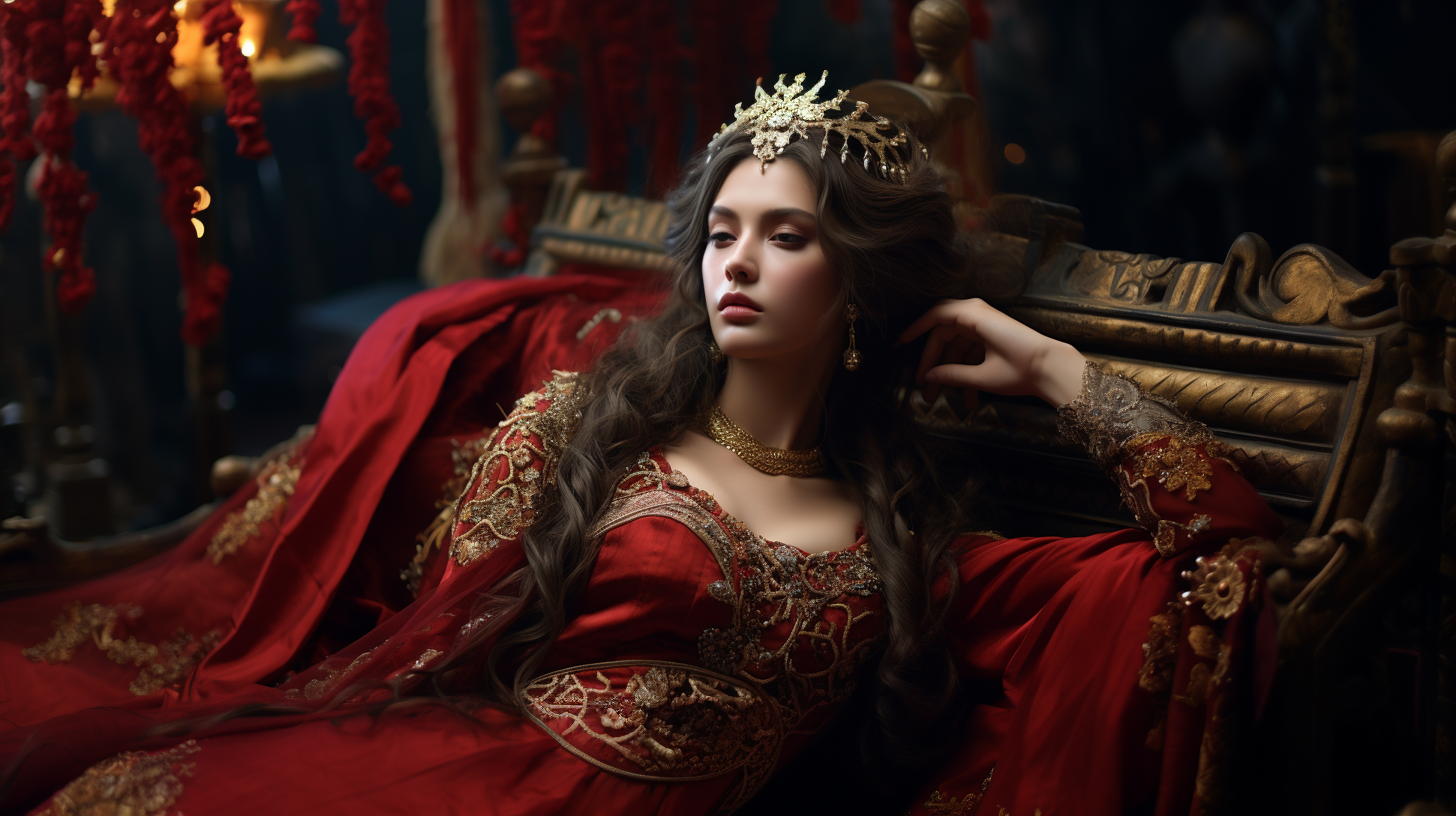
“image: A woman adorned in an opulent robe of deep crimson silk, her attire
bursting with intricate golden embroidery. She stands regal, as if she owns the
world, her hairstyle meticulously crafted to signify her noble standing. Capturing
the essence of ancient Chinese fashion at its pinnacle, a world of unimaginable
luxury and symbolic depth.“
So, buckle up. This is going to be a mesmerizing ride through a spectrum of colors, fabrics, and styles that did more than just make a person “look good” — they defined empires, they dictated traditions, and yes, they transformed mere mortals into legends. Let’s go ahead and unfold these luxurious pages of history, shall we?
Unraveling Threads: The Xia and Shang Dynasties Stitching the Blueprint of Fashion
In the annals of Chinese history, the Xia and Shang dynasties are akin to the nascent seeds of a plant that has yet to bloom, but whose roots already signify the beauty it’s destined to unfold. This period doesn’t just mark the inception of dynastic rule; it sews the first stitches in the extensive quilt of Chinese dynasties fashion. But remember, we’re not just talking about fabrics here; it’s an age where threads were spun not just on looms but in the intricate tapestry of societal norms, symbolism, and spirituality.
The Advent of Silk and its Primordial Significance
Silk. Oh, what a marvelous material, even by modern standards. But in the context of ancient China, it was nothing short of revolutionary. Here’s a fabric that managed to encompass aesthetic splendor and utilitarian durability, all while symbolizing the very virtues that society held dear: purity, simplicity, and natural beauty. The legend of Silk’s discovery involves a tea, a cocoon, and an empress—imagine taking your daily cuppa and stumbling upon a textile that would revolutionize fashion for millennia.
Image Placeholder: Envision a weaver in an ancient Chinese dwelling, meticulously crafting silk threads on a primitive loom. The image captures the ethereal quality of the silk, set against the rustic simplicity of the environment.
The Sartorial Palette of the Xia and Shang
In these archaic times, clothing wasn’t a cacophony of colors but rather a subdued blend of nature-inspired hues. Think earthy browns, celestial whites, and serene blues. Clothing mostly consisted of wraps and simple robes, held together by sashes or ornamental pins. Ah, but don’t be misled by the apparent simplicity; each garment was a distinct representation of social hierarchy and ritualistic importance. Even the choice of a sash color could indicate one’s relationship to power.
Hairstyles and Accessories: Not Just for Adornment
In these dynasties, your coiffure wasn’t merely a style choice; it was a walking, talking (or should I say, “sitting, silent?”) announcement of your social standing. People adorned their locks with combs made from bones and intricate hairpins. Men often tied their hair in a bun and covered it with a headdress or a cap during formal occasions. Women, on the other hand, took it up a notch. They embellished their hairstyles with a variety of adornments ranging from simple beads to elaborate ornaments, turning their hair into a veritable canvas of self-expression and social signaling.
The Brocade Era: The Zhou Dynasty Weaving Elegance into Existence
As the Zhou dynasty took over the helm of China’s evolutionary ship, a transformation unfolded that couldn’t be understated. The Zhou era didn’t merely continue the fashion traditions of its predecessors; it wove its philosophies, ethics, and aesthetics into every thread, creating textiles that were more than just garments. They were statements, declarations, even epitaphs written in silk and dyed in opulent hues.
Unfurling the Canvas: The Intricacies of Brocade
The crowning jewel of Zhou fashion was undoubtedly the brocade, a fabric woven on a drawloom with sumptuous patterns that often told stories or represented revered motifs like dragons, phoenixes, and other mythical beings. These textiles weren’t merely decorative; they were emblems of culture, capturing the essence of Confucian principles and Daoist philosophies. You could look at a robe and, if educated in the nuances of its design, read it like a scroll detailing the ethics, religious beliefs, and even the societal status of the wearer.
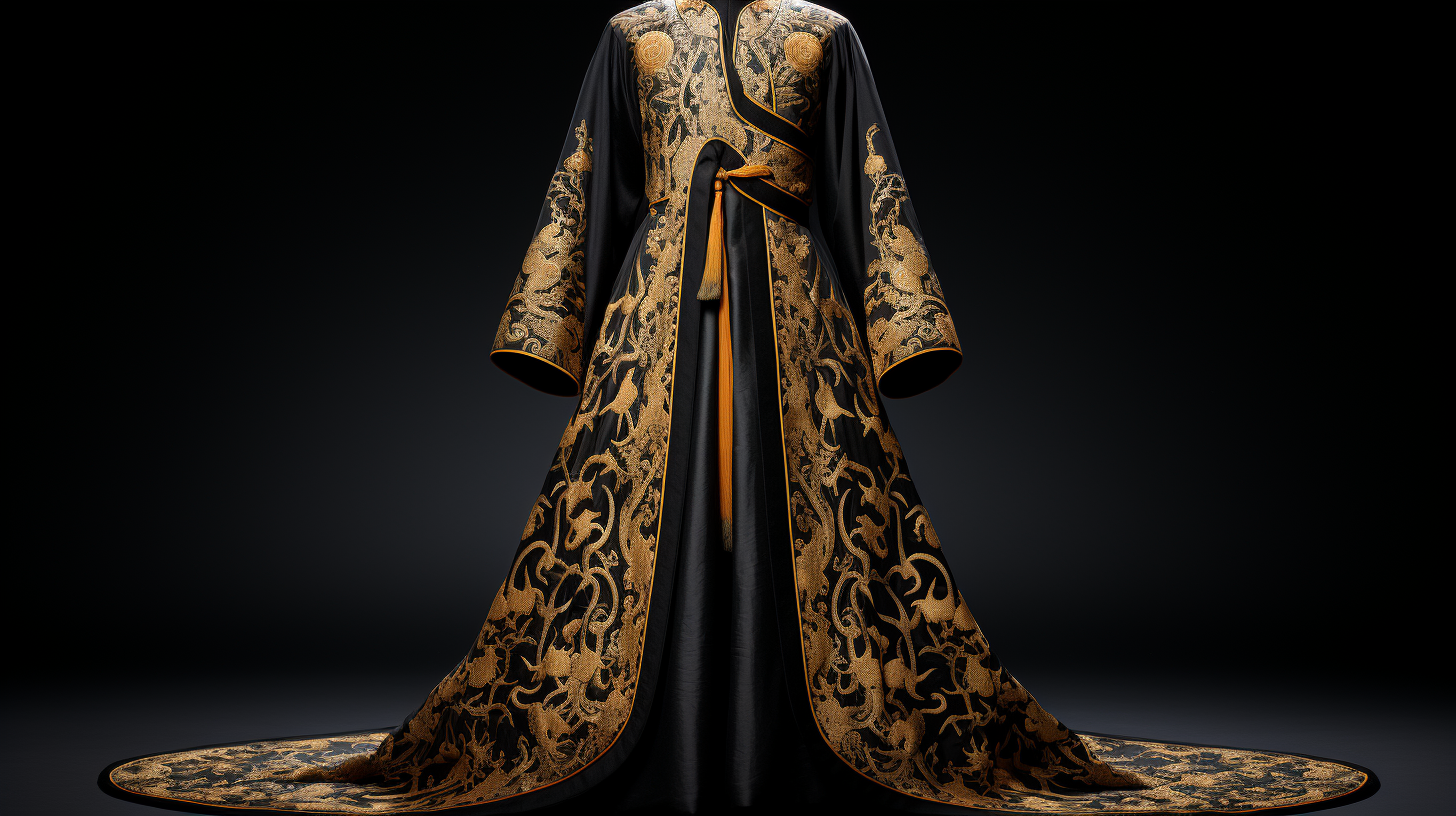
Image: An intricately designed brocade robe on display against
a dark backdrop. The intricate patterns in gold thread shimmer in the subdued
light, capturing the grandeur of the Zhou dynasty. It’s not just a garment; it’s a
biography woven in silk.
Philosophy Woven into Fabric: Confucianism and Daoism
It’s impossible to discuss Zhou fashion without delving into the influence of Confucianism and Daoism. Confucianism, with its strictures on morality and social harmony, found expression in the sober, dignified attire of the scholars and bureaucrats. Daoism, in contrast, inspired the simpler, flowing garments of the hermits and monks—outfits that were an extension of their quest for unity with nature. But whether Confucian or Daoist, the clothes were always more than mere fashion; they were an extension of the self, a visual representation of deeply held beliefs.
The Palette of Power: Color Symbolism in Zhou Clothing
Here comes the Zhou dynasty, turning even the color wheel into a microcosm of the world view. Red for good luck and joy, black representing water, and gold symbolizing wealth and power—the spectrum wasn’t just a visual feast but a semiotic language. This vivid palette was not arbitrary; it correlated with the Five Elements theory, intertwining fashion deeply with cosmology and metaphysics.
The Apex of Allure: Fashion in the Qin and Han Dynasties
Fasten your seat belts, because now we’re diving into an era that brought about tectonic shifts not just in the political landscape but also in the sartorial sensibilities of ancient China. The Qin and Han dynasties didn’t just stop at unifying China; they orchestrated an amalgamation of fashion, weaving together a tapestry that symbolized both power and diversity. Let’s pull this thread and see where it leads us, shall we?
The Unification of Styles under the Qin
The Qin Dynasty was a stickler for standardization. From weights and measures to scripts and even axles of chariot wheels—everything was standardized, including fashion. Suddenly, you had a harmonized dress code across the newly unified realm. Robes with wide sleeves and round collars became the order of the day, heavily influenced by the military garb of the period. This standardization was not just an aesthetic choice but a political statement, mirroring the strict governance and centralized control.
Image Placeholder: Picture a scene from the terracotta army: ranks of clay soldiers wearing uniforms that would be replicated in the robes of civilians. Each figure stands as a testament to the grandeur and uniformity of the Qin era.
The Han Dynasty’s Syncretic Fashion
The Han dynasty took a more laid-back approach compared to the Qin’s rigidity. Think of it as the remix era of Chinese fashion, blending indigenous styles with influences from as far afield as the Silk Road. Silk remained a luxurious staple, but fashion started to evolve to include a variety of textiles like hemp, linen, and wool. It wasn’t just about what you wore but how you wore it—layers became a popular trend, allowing for more individual expression within the confines of cultural norms.
Evolution of Accessories and Ornaments
As the Han dynasty unfurled, so did the repertoire of accessories. Intricate hairpins, ornate necklaces, and even talismanic pendants found their way into the fashion narrative. But accessories weren’t merely decorative; they often signified the rank and social status of the wearer. Gold for the nobility, jade for scholars, and simpler materials for the common folk—each trinket was a walking advertisement for who you were in the societal hierarchy.
The Tang Dynasty: Where Silk Meets the World
Folks, if the Han dynasty was a laid-back jam session in the history of Chinese dynasties fashion, the Tang dynasty was a full-blown rock concert. This era was like a cosmopolitan metropolis of fashion, a melting pot that welcomed influences from across continents. But make no mistake; while the influences were many, the resulting style was undeniably, quintessentially Tang. Let’s get into it.
A Melting Pot of Styles
The Tang dynasty was a period when China was connected to the world as never before. The Silk Road was bustling, not just with goods but also with ideas, technologies, and yes, fashions. While silk remained a coveted item, other fabrics like cotton began to appear on the scene. This was a period that celebrated diversity in dress like no other; long robes, short jackets, wide sleeves, and narrow cuffs—each style had its place in the Tang wardrobe. The fashion became a lively palette, mirroring the multi-cultural tapestry of the empire.
Image Placeholder: Imagine a Tang marketplace filled with a dizzying array of textiles, from Chinese silks to Persian carpets, and people of diverse backgrounds—each contributing to a vibrant style spectrum. An atmosphere bustling with excitement and cultural exchange.
Feminine Elegance in Tang Fashion
Elegance was the order of the day when it came to women’s fashion in the Tang dynasty. It wasn’t merely about what one wore but how one wore it. Drapes, layers, and sashes were used with an eye for grace and poise. But it wasn’t just the nobility who had a monopoly on fashion; women from all walks of life sought to express themselves through clothing, whether it was through color, cut, or pattern.
The Influence of Foreign Trade
The Tang dynasty was a period of unprecedented economic growth, and that meant more than just money flowing into the empire. Fashion influences, too, traversed along the trade routes, infiltrating the local styles and transforming them into something new, yet distinctively Tang. Central Asian styles, Indian motifs, and even Byzantine elements found their way into the Chinese wardrobe.
The Song Dynasty: The Art of Subtlety
If the Tang dynasty was a cacophony of colors and a riot of styles, the Song dynasty was the opposite—a carefully orchestrated symphony of understatement and nuance. As we journey further into the annals of Chinese dynasties fashion, the Song era offers us a respite and lesson in the power of subtlety. Let’s delve into it, shall we?
Understated Elegance
The Song dynasty may have been less extravagant than its predecessor, but it had an elegance all its own. Clothing, while more subdued in color, drew attention to itself through the intricacy of its design. Embroideries were smaller but more detailed, often narrating a story or portraying an idyllic scene. Fashion was less about a statement and more about a story.
Image Placeholder: A depiction of a Song-era robe, with intricate yet understated embroidery. The garment tells a tale of its own, portraying scenes of nature in subdued, calming hues.
The Rise of Neo-Confucianism and its Influence on Fashion
Neo-Confucianism reemerged strongly during this period, impacting societal norms and, by extension, fashion. Traditional Confucian values of modesty and restraint were reflected in the styles of the time. Clothing was made to be functional yet beautiful, reflecting a balance between the aesthetic and the pragmatic. Layering was used not just as a fashion statement but also as an expression of philosophical beliefs, each layer representing a different aspect of the self.
The Status Symbol of Fashion
Status was conveyed less through ostentation and more through quality and detail in the Song dynasty. The refinement of the fabric, the subtlety of the embroidery, and even the way a garment was layered could tell you much about the wearer’s social standing. The highest quality silks and intricate patterns were reserved for the imperial family and high-ranking officials, while commoners were restricted in terms of color and complexity.
The Ming Dynasty: The Looms of Innovation
In the grand tapestry of Chinese dynasties fashion, the Ming era represents a profound shift—a shift deeply rooted in innovation, scientific inquiry, and a societal structure that reflected a new intellectual curiosity. After the subtleties of the Song, the Ming dynasty unveils a fascinating confluence of tradition and technology. So, let’s not tarry. Onward, into a world of looms and sea voyages!
Technological Advances in Textiles
Advancements in textile technology during the Ming dynasty were nothing short of revolutionary. The introduction of new weaving techniques and dyeing processes breathed fresh life into the fashion of the time. These innovations allowed for more intricate designs, finer fabrics, and a wider range of colors. The garments were no longer just clothes; they became canvases for artisans to display their mastery.
Image Placeholder: An intricately designed Ming Dynasty robe, showcasing technological advancements in textile weaving and dyeing. Each thread and color is purposefully chosen, displaying an extraordinary level of craftsmanship.
The Great Voyage and Cultural Exchanges
The maritime expeditions led by explorers like Zheng He not only expanded the empire’s geographical knowledge but also facilitated cultural exchange. Imported materials like wool and velvet started appearing in Ming-era clothing. The influence of distant lands became evident in the designs, as motifs from the Middle East and even Africa began to be integrated into traditional Chinese garments. It was the dawn of a more cosmopolitan fashion sense.
Fashion as a Political Tool
Clothing in the Ming era also became a medium for political messaging. Specific designs and patterns were often associated with specific ideas or causes, and they became a way for individuals to express their political leanings or loyalties. Additionally, the bureaucracy, which had always influenced fashion to some extent, now had codified laws specifying which ranks could wear which colors and fabrics, making clothing an overt badge of one’s social and political standing.
The Qing Dynasty: The Last Canvas
As the sun set on China’s era of imperial rule, the Qing Dynasty emerged as a final, magnificent flourish—a period awash with both grandeur and contradiction. The Qing era was the last canvas on which China’s age-old relationship with fashion would be painted, but it’s far from a mere afterthought. This was a period marked by the arrival of the Manchus, strict dress codes, and the undercurrents of rebellion that would eventually usher in a new age. It’s a rich tapestry, so let’s delve into the folds.
Manchu Influence: A Fusion of Old and New
The Manchus, originally a foreign power, brought with them not only a new governance but also their unique fashion sensibilities. The most striking example is the “Qipao” or “Cheongsam,” a one-piece dress that over time became symbolic of Chinese femininity. Initially, it was a Manchu creation, but it beautifully mingled with the existing Han fashion traditions, becoming a fashion icon that transcended ethnic divides.
Rigid Dress Codes: Cloth and Command
The Qing dynasty enforced some of the most rigid dress codes in Chinese history. Your clothing indicated not just your social status but also your ethnic identity. For instance, the Manchus had their distinct fashion items, like the “Mandarin Square,” a patch indicating rank and ethnicity. This patch was to be displayed prominently on the clothing, and failure to do so could result in severe consequences, bringing a dimension of legal and social control to fashion that was unprecedented.
The Fashion of Rebellion: Threads of Change
While the court insisted on specific styles and attire, the common people found ways to rebel against these strictures through their clothing. Hidden in the intricate embroideries were subtle symbols of resistance—be it the representation of specific plants, animals, or mythological motifs. These became codes among the informed, ways of expressing dissatisfaction with the ruling class without openly breaking any laws.
Image Placeholder: A selection of Qing Dynasty robes, featuring both Manchu and Han styles side by side. The detailed embroideries, colors, and patches illustrate the complex interplay of power, ethnicity, and resistance during this era.
Contemporary Echoes: China’s Fashion Renaissance
From the fabric of antiquity to the warp and weft of modernity, Chinese fashion is anything but a relic. It is a dynamic, ever-evolving force, mirroring the country’s rapid social and economic transformations in recent decades. As we navigate this remarkable resurgence, three themes become apparent: the shadow of the Cultural Revolution, the rise of indigenous designers, and the interaction between global fashion and Chinese identity.
The Cultural Revolution’s Impact: Stitching Over Old Wounds
We cannot appreciate the modern tapestry without first understanding the rough patchwork of the Cultural Revolution. In those tumultuous years, fashion was stigmatized, equated with bourgeois decadence. Uniformity was promoted, suppressing individualism and sartorial innovation. The drab “Mao suits” were ubiquitous. It’s essential to recognize this period for the immense impact it had on shaping public attitudes towards fashion, even though it’s taken several decades to shake off its influence fully.
The Rise of Homegrown Designers: Fresh Threads, New Canvases
Emerging from the cloud of the Cultural Revolution is a bright constellation of homegrown talent. Names like Guo Pei and Uma Wang may not have been household names two decades ago, but today they command international respect. These designers have a dual legacy—they are both Chinese and global. Their work reflects an astute understanding of their cultural heritage, yet they are not bound by it. Through their eyes, Chinese fashion is neither anachronistic nor static; it is a dialogue between the past and the present, each enriching the other.
Global Fashion and Chinese Identity: The Two-Way Loom
China’s interaction with the global fashion world is a complex dance. On one hand, Western brands dominate the luxury market, with cities like Shanghai and Beijing hosting flagship stores for almost every notable name in haute couture. On the other, Chinese elements are increasingly prevalent in Western fashion. Be it the mandarin collar, embroidered silks, or the color red, such motifs are more than exotic accessories; they are a nod to a civilization with millennia of fashion history. However, this two-way exchange is not without its challenges, particularly in the realms of cultural appropriation and authenticity.
Image Placeholder: A contemporary Chinese runway show featuring designs that combine traditional elements like silk brocades and modern silhouettes, capturing the essence of China’s current fashion landscape.
The Final Stitch: Weaving Together China’s Fashion Tapestry
Alright, so we’ve been on a whirlwind journey, haven’t we? From emperors to empresses, ancient silks to Mao suits, and back to contemporary runways where tradition and innovation are locked in this beautiful, intricate dance. It’s been a wild ride, but as we always do, let’s tie up some loose ends.
The Timeless Fabric of Chinese Fashion
You see, fashion isn’t just clothes; it’s a statement, a form of expression. In the context of China, this expression has spanned centuries, dynasties, and ideologies. But through it all, the essence remains the same: a deep-seated respect for craftsmanship, a subtle interplay between form and function, and a nuanced appreciation of beauty. Whether you’re walking through the Forbidden City or down a bustling modern street in Shanghai, the threads of the past are still very much woven into the fabric of the present.
Fashion as a Mirror to Society
In the end, fashion is more than just material; it’s metaphysical. It reflects the collective aspirations, struggles, and identity of a society. For China, that’s a tapestry rich with historical motifs and colorful patches of modernity. So, when you see a qipao, don’t just see a dress; see a narrative. When you look at a Mao suit, see beyond the drab, gray fabric to the social currents it represents. And when you observe a cutting-edge design by a Chinese artist, understand that it’s more than just a piece of clothing. It’s a statement. A statement that says, “We’re here, we’ve got a hell of a story to tell, and we’re not done yet.”
Image Placeholder: A collage of various fabrics, from ancient silk brocades to modern textiles, layered and interwoven, representing the complex and evolving story of Chinese fashion.
Farewell to the Catwalk: A Last Sip of Chinese Fashion’s Rich Brew
So, here we are at the end of our multi-course feast, spanning the depths of history to the cutting edge of now. From emperors’ gowns to punk-inspired rebels, we’ve tasted it all. Let’s simmer down, look at our empty plates—rife with the residue of cultural evolution—and ponder a bit, shall we?
The Last Nostalgic Nibble
In the world of fashion, as in life, what’s old becomes new and what’s new inevitably becomes old. In China, this cycle is like a fine wine; it’s complex, it’s enriching, and it’s been aging for millennia. To grasp it in its entirety is a humbling exercise. You realize that each piece of fabric tells a story, each color, a mood, and each style, a perspective. They are all floating fragments in a complex broth of a culture that has thrived through revolution and rebirth.
An Encore with a Twist
Just when you think you’ve figured out the keynotes of Chinese fashion, it throws in a wild card—unexpected, disruptive, but harmoniously fitting into the larger palette. You see, the canvas is still wet. Contemporary designers are no longer just borrowing from the past; they are redefining it. Whether it’s the playful integration of Western motifs or a daring reinterpretation of traditional textiles, the bottom line is: expect the unexpected.
The Sip That Lingers
The aftertaste, the lingering note that stays with you long after the feast—that’s the genius of Chinese fashion. It’s that thing you can’t quite put your finger on, but you know it’s been carved through years of artistry, innovation, and a sprinkle of audacity. It’s that umami; rich, multi-layered, and entirely indescribable.
Image Placeholder: A mosaic of diverse faces, each wearing a different traditional or modern Chinese fashion element, forming a complex tapestry that is both singular and multi-faceted, like a perfectly balanced dish.
The Final Curtain Call: A Heartfelt Salute to the Maestros and Enthusiasts
Alright, my friends, here we are—the conclusion of a grand tour that’s taken us through Chinese fashion from its most ancient threads to its modern tapestry. This story couldn’t be written, much less appreciated, without a cast of unforgettable characters. So, let’s roll those credits.
Appreciating the Craftsmen
First up, the real architects of this narrative: the craftsmen. The weavers, tailors, embroiderers, and artisans. These unsung heroes are the keystones in the arch of Chinese fashion. Working often in the shadows, with hands more eloquent than words, they’ve stitched together centuries of cultural identity. Their tools? Dedication, tradition, and an unyielding commitment to their art. It’s impossible to look at a piece of intricate brocade or hand-painted silk without standing in awe of their skills.
Thanking the Contributors
Next in line, we’ve got the contributors—designers, researchers, scholars, and yes, even bloggers. They’re the bridge between the old and the new, the translators of a complex lexicon of stitches and styles. They comb through the annals of history, scrutinize patterns and fabrics, and set trends that make us look twice. Their contributions are like a mirror that reflects not just the garment, but the epoch it represents.
A Nod to the Readers
Finally, there’s you—the readers. You’re the ones who bring life to the pages, who don the styles, who make Chinese fashion a living, breathing entity. Whether you’re a fashion enthusiast, a curious historian, or someone who stumbled upon this blog, your engagement is the final stitch in this complex pattern. You question, you ponder, and most importantly, you appreciate. Without your gaze, these words and the fashion they describe would be like an unviewed painting in a closed gallery.
Image Placeholder: A collage featuring the hands of an artisan at work, a designer sketching on a pad, and a reader engrossed in a book about fashion, symbolizing the interconnected roles each plays in the world of Chinese fashion.
And there you have it. This narrative is as complete as any can be in a field as dynamic as fashion. From those who create to those who curate and finally to those who consume, it’s a cycle that keeps the runway ever vibrant. So, here’s to the next chapter—may it be just as fascinating, just as intricate, and just as unforgettable as the last. Onwards!



